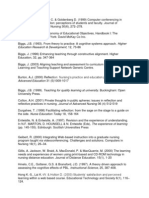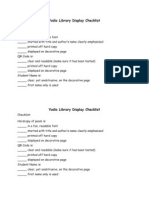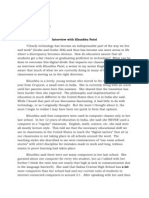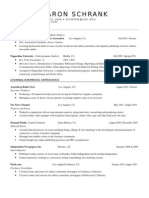Backward Design and Effective Student Learning
Backward Design and Effective Student Learning
Uploaded by
api-148362218Copyright:
Available Formats
Backward Design and Effective Student Learning
Backward Design and Effective Student Learning
Uploaded by
api-148362218Original Title
Copyright
Available Formats
Share this document
Did you find this document useful?
Is this content inappropriate?
Copyright:
Available Formats
Backward Design and Effective Student Learning
Backward Design and Effective Student Learning
Uploaded by
api-148362218Copyright:
Available Formats
References Backward Design and Effective Student Learning: Anonymous. (2009). High school student engagement.
Gifted Child Today, 32(2), 6. Retrieved April 15, 2011, from the ProQuest database. Kelting-Gibson, L. (2005). Comparison of curriculum development practices. Educational Research Quarterly, 29(1), 26-36. Retrieved April 16, 2011, from the ProQuest database. McTighe, J. & Thomas, R. S. (2003). Backward design for forward action. Educational Leadership, 60(5), 52-55. Retrieved April 15, 2011, from the Wilson Web database. McTighe, J., & O'Connor, K. (2005). Seven practices for effective learning. Educational Leadership, 63(3), 10-17. Retrieved April 15, 2011, from the Wilson Web database. McTighe, J., & Brown, J. (2010). Differentiated instruction and educational standards: Is detente possible?. Theory Into Practice, 44(3), 234-244. Retrieved April 16, 2011, from http://pdfserve.informaworld.com/550049__789375333.pdf Principles of backward design. (2004, November 5). Tasmanian Department of Education. Retrieved March 19, 2011, from www.wku.edu/library/infolit/libraryfacultydocuments/Designing_lesson_plans_u sing_Backwar_Design.pdf Richardson, J. (2009). Evidence of Learning: A conversation with Jay McTighe. The Education Digest, 74(6), 37-42. Retrieved April 15, 2011, from the ProQuest database. Rourke, J., & Hartzman, M. (2008). Calling for excellence with one voice. Principal
Leadership, 8(10), 36-39. Retrieved April 15, 2011, from the ProQuest database. Schmoker, M. J. (2011). Focus: Elevating the essentials to radically improve student learning. Alexandria, Va.: ASCD. Umphrey, J. (2008). This is a test. Principal Leadership, 9(1), 4. Retrieved April 15, 2011, from the ProQuest database. Wiggins, G. & McTighe, J. (2008). Put understanding first. Educational Leadership, 65(8), 36-41. Retrieved April 15, 2011, from the Wilson Web database. Wiggins, G. (2009). Real-World writing: Making purpose and audience matter. English Journal, 98(5), 29-37. Retrieved April 15, 2011, from the ProQuest database. Wong, H. K., & Wong, R. T. (1998). The first days of school: How to be an effective teacher ([2nd ed.). Mountainview, CA: Harry K. Wong Publications. Change Models: Ellsworth, James B.. Surviving change: a survey of educational change models. Syracuse, N.Y.: Clearinghouse on Information & Technology, Syracuse University, 2000. Print. Rogers, Everett M.. Diffusion of innovations. 4th ed. New York: Free Press, 1995. Print. Curriculum Development: Carey, K. (2009, June 18). USA vs. the world. The quick and the ed - Education sector. Retrieved July 7, 2010, from www.quickanded.com/2009/06/usa-vs-world.html Counts, G. (2009). Dare the school build a new social order?. The Curriculum Studies Reader (3 ed., pp. 45-51). New York: Routledge. Dewey, J. (1915). The School and society & The child and the curriculum. New York: Dover Publications.
Eisner, E. (2009). What does it mean to say a school is doing well?. The Curriculum Studies Reader (3 ed., pp. 327-335). New York: Routledge. English, F. (n.d.). Curriculum focuses and connects the work of school professionals. NA. Retrieved July 7, 2010, from spotswood.groupfusion.net/modules/groups/homepagefiles/cms/462809/File/Dist rictDocuments/Curriculum/DistrictCurriculumDescription.pdf?sessionid=0cec96 ffbfd482cb767395bc1cea Freire, P. (2009). Pedagogy of the oppressed. The Curriculum Studies Reader (3 ed., pp. 147-154). New York: Routledge. Glod, M. (2007, December 5). U.S. teens trail peers around world on math-science test. The Washington Post. Retrieved July 7, 2010, from http://www.washingtonpost.com/wpdyn/content/article/2007/12/04/AR2007120400730.html Hughes, G. (2002). Aligning curricula and standards in an era of accountability. Laboratory for Student Success, 702, 1-2. Labaree, D. (2000). Resisting educational standards. Phi Delta Kappan, 81(1), 28-33. Marsh, C. J., & Willis, G. (2007). Curriculum: Alternative Approaches, Ongoing Issues (4th Edition) (4 ed.). Alexandria, VA: Prentice Hall. Montessori, M. (2009). A critical consideration of the new pedagogy in its relation to modern science. The Curriculum Studies Reader (3 ed., pp. 22-33). New York: Routledge. National education standards not a federal takeover of public schools. (2010, March 31). The Christian Science Monitor, n.a.. Retrieved July 7, 2010, from
http://www.csmonitor.com/Commentary/the-monitors-view/2010/0331/Nationaleducation-standards-not-a-federal-takeover-of-public-schools Noddings, N. (2009). The aims of education. The Curriculum Studies Reader (3 ed., pp. 425-438). New York: Routledge. Tyler, R. (2009). Basic principles of curriculum and instruction. The Curriculum Studies Reader (3 ed., pp. 69-77). New York: Routledge. Distance Education for High School Students: Albright, M., Simonson, M., Smaldino, S. E., & Zvacek, S. (2008). Teaching and learning at a distance: Foundations of distance education (4 ed.). Alexandria, VA: Prentice Hall. Cavanaugh, C., Gillan, K., Kromrey, J., Hess, M., & Blomeyer, R. (2004). The effects of distance education on K-12 student outcomes: A meta-analysis. Learning Point Associates, n.a.. Retrieved September 7, 2010, from http://www.ncrel.org/tech/distance/k12distance.pdf Why high school online? Benefits of online high school classes and online high school programs. (n.d.). Online High School Program for Homeschooling - Allied High School. Retrieved September 9, 2010, from http://www.alliedhighschool.com/aa_distance-ed.shtml Distance Education Theories: Albright, M., Simonson, M., Smaldino, S. E., & Zvacek, S. (2009). Teaching and Learning at a Distance: Foundations of Distance Education (4 ed.). Alexandria, VA: Prentice Hall. Andragogy (M. Knowles). (n.d.). Theory Into Practice (TIP). Retrieved September 25,
2010, from http://tip.psychology.org/knowles.html Paulsen, M. (n.d.). Cooperative freedom: An online education theory. Education Online. Retrieved September 23, 2010, from www.studymentor.com/cooperative_freedom.pdf Simonson, M., Schlosser, C., & Hanson, D. (1999). Theory and distance education: A new discussion. The American Journal of Distance Education, 13(1). Retrieved September 24, 2010, from http://www.c3l.unioldenburg.de/cde/found/simons99.htm Wedemeyer, C. (1981). Learning at the back door:Reflections on non-traditional learning in the lifespan. Madison: University Of Wisconsin. Mobile Learning (M-Learning): 7 things you should know about mobile apps for learning. (2010, May 1). Educause. Retrieved November 22, 2010, from http://www.educause.edu/Resources/7ThingsYouShouldKnowAboutMobil/2047 63 Eifler, K. (2010, September 2). Cell phones in the classroom: Is it time to reconsider your policy?. Effective Teaching Strategies for the College Classroom | Faculty Focus. Retrieved November 22, 2010, from http://www.facultyfocus.com/articles/trends-in-higher-education/cell-phones-inthe-classroom-is-it-time-to-reconsider-your-policy/ Jobe, P. (2009). Cell phones in the (language) classroom: Recasting the debate. EDUCAUSE quarterly, 32(4). Retrieved November 15, 2010, from http://www.educause.edu/Educause+Quarterly/EducauseQuarterlyMagazineVolu
m/CellPhonesintheLanguageClassro/192995 Kennedy-Manzo, K. (2010). Mobilizing the research: Experts say more-rigorous research is needed to build a case for mobile learning. Education Week, 29(26), 34. Retrieved April 16, 2011, from the ProQuest database. Lepkowska, D. (n.d.). Mobile learning for schools - a class without walls. The Guardian | guardian.co.uk . Retrieved November 22, 2010, from http://www.guardian.co.uk/resource/a-class-without-walls/print Obringer, J., & Coffey, K. (2007, Spring). Cell phones in American high schools: A national survey. The Journal Of Technology Studies, 33, 41-47. Retrieved November 23, 2010, from the Education Resources Information Center database. Ramaswami, R. (2008, May 1). Fill 'er up. The Journal: Technological Horizons in Education -- THE Journal. Retrieved November 22, 2010, from http://thejournal.com/articles/2008/05/01/fill-er-up.aspx Troutner, J. (2010). Mobile Learning. Teacher Librarian, 38(1), 44. Retrieved April 16, 2011, from the ProQuest database. Wagner, E. (2005). Enabling Mobile Learning. Educause Review, 40(3). Retrieved November 20, 2010, from http://www.educause.edu/Educause+Review/EducaseReviewMagazineVolume4 0/EnablingMobileLearning/157976 Wehril, B. (2009). Technology as a fence and a bridge. Coalition of Essential Schools, 25(1), n.p.. Retrieved November 23, 2010, from the Education Resources Information Center database. Multicultural Education:
Banks, J. A. (2006). Cultural diversity and education: Foundations, curriculum, and teaching (5th ed.). Boston: Pearson/Allyn and Bacon. King, J. (1991). Dysconscious racism:Ideology, identity, and the miseducation of teachers. Journal of Negro Education, 60(2), 113-146. Sue, D. W., Capodilupo, C., Torino, G., Bucceri, J., Holder, A., Nadal, K., et al. (2007). Racial microaggressions in everyday life: Implications for clinical practice. American Psychologist, 62(4), 271-286. QR Codes: Byrne, R. (2011). QR codes go to school. School Library Journal, 57(12), 16. Retrieved March 12, 2012, from the ProQuest database. Miller, A. (2011, December 5). Twelve ideas for teaching with QR codes. Edutopia. Retrieved March 26, 2012, from http://www.edutopia.org/blog/QR-codesteaching-andrew-miller Patel, K. (2012). Quick response codes. Advertising Age, 83(1), 2. Retrieved March 10, 2012, from the ProQuest database. Robertson, C., & Green, T. (2010). Scanning the potential for using QR codes in the classroom. TechTrends, 56(2), 11-12. Tucker, A. (2011). What are those checkerboard things? How QR codes can enrich student projects. Tech Directions, 71(4), 14-16. Retrieved March 10, 2012, from the ABI/INFORM Global database. Research Methods: College Credits Earned in High School: Andrews, H. (2001). The dual-credit phenomenon!: Challenging secondary school students across 50 states. Stillwater: New Forums Press.
JBHE, F. (2004). College-bound black students are making inroads in advance placement tests. The Journal of Blacks in Higher Education, 44, 99-103. Retrieved September 15, 2011, from the JSTOR database. Karp, M., Calcagno, J., Hughes, K., Jeong, D., & Bailey, T. (2007). The postsecondary achievement of participants in dual enrollment: An analysis of student outcomes in two states. National Research Center for Career and Technical Education, 175. Kleiner, B., & Lewis, L. (2005). Dual enrollment of high school students at postsecondary institutions: 2002-03. National Center for Educational Statistics, 1-83. Smith, T. (n.d.). Chapter 1: Elementary and secondary education: Transition to higher education. nsf.gov - National Science Foundation (NSF). Retrieved September 15, 2011, from http://nsf.gov/statistics/seind02/c1/c1s9.htm Swanson, J. (2007). Partners for student success. Principal Leadership, 7(7), 26-30. Retrieved September 15, 2011, from the ProQuest database.
You might also like
- Letter of RecommendationDocument2 pagesLetter of Recommendationapi-5325882060% (1)
- Beowulf Circles - Senior - Entire Literature Circle Information and FormsDocument8 pagesBeowulf Circles - Senior - Entire Literature Circle Information and Formsapi-148362218No ratings yet
- MKC1200 - Practice Exam PaperDocument3 pagesMKC1200 - Practice Exam PaperAltovistaNo ratings yet
- Chapter 1 MCQs in Introduction To Data CommunicationDocument11 pagesChapter 1 MCQs in Introduction To Data CommunicationIan Von Arandia100% (1)
- Social Media Capstone ProjectDocument4 pagesSocial Media Capstone Projectapi-307579887No ratings yet
- GPON OLT Quick Configuration User Manual: About ProductDocument56 pagesGPON OLT Quick Configuration User Manual: About Producttegar gaming100% (1)
- Teaching With Technology (P. 75-108) - San Francisco: Jossey-Bass. Retrieved FromDocument4 pagesTeaching With Technology (P. 75-108) - San Francisco: Jossey-Bass. Retrieved FromRebecca SkucasNo ratings yet
- References PDFDocument7 pagesReferences PDFresigjeflinNo ratings yet
- Reference PageDocument6 pagesReference PageJoshua CoxNo ratings yet
- Tocci CV May 2020Document16 pagesTocci CV May 2020ctocci7No ratings yet
- REFERENCESDocument3 pagesREFERENCESoseisilasyawNo ratings yet
- 06 BackDocument68 pages06 Backaderina9032No ratings yet
- ReferencesDocument3 pagesReferencesapi-301740389No ratings yet
- References: Teacher Education, 32 (1), 65-72Document2 pagesReferences: Teacher Education, 32 (1), 65-72Shuu KenjiNo ratings yet
- 9Document18 pages9FrancisLekololiNo ratings yet
- !references ArDocument8 pages!references ArFelicia OngNo ratings yet
- Daftar PustakaDocument4 pagesDaftar PustakaNaomi Putri Purba0% (1)
- REFERENCESDocument4 pagesREFERENCESRudy LangiNo ratings yet
- School Form 10 SF10-SHS Senior High School Student Permanent RecordDocument4 pagesSchool Form 10 SF10-SHS Senior High School Student Permanent RecordRolly Dominguez BaloNo ratings yet
- Biblio Graph 1Document3 pagesBiblio Graph 1Dennis l. CapuyanNo ratings yet
- Siming Feng ReferencesDocument5 pagesSiming Feng Referencesapi-269225610No ratings yet
- REFERENCESDocument12 pagesREFERENCESRichelle IldefonsoNo ratings yet
- Tocci CV Jan 2023Document18 pagesTocci CV Jan 2023C TocciNo ratings yet
- REFERENCESDocument2 pagesREFERENCESQuoc Nam VuongNo ratings yet
- Tinto VitaDocument15 pagesTinto Vitaeps68No ratings yet
- Omde601 9020 Readings ReferencesDocument6 pagesOmde601 9020 Readings Referencesapi-295474435No ratings yet
- BIBLIOGRAFIE FundamentareDocument10 pagesBIBLIOGRAFIE FundamentareCostel-Daniel NeicuNo ratings yet
- REFERENCE ChiomaDocument3 pagesREFERENCE ChiomaAgboeze samsilverNo ratings yet
- Osborne2010 ArgumentEducationDocument5 pagesOsborne2010 ArgumentEducationjungck8715No ratings yet
- Tocci CV August 2019 UpdatedDocument15 pagesTocci CV August 2019 Updatedctocci7No ratings yet
- Lahore University of Management Sciences SOC 223 - Sociology of EducationDocument6 pagesLahore University of Management Sciences SOC 223 - Sociology of Educationblah blah 56743No ratings yet
- Dapus EditDocument7 pagesDapus EditRina Dyah RahmaNo ratings yet
- AppendicesDocument32 pagesAppendicesivy malanogNo ratings yet
- Daftar PustakaDocument7 pagesDaftar PustakaYuLi SubektiNo ratings yet
- Active Learning and Learning Styles: A Selected BibliographyDocument9 pagesActive Learning and Learning Styles: A Selected BibliographyCharlie SanchezNo ratings yet
- Daftar Pustaka. Per 1 JUNI 2016Document8 pagesDaftar Pustaka. Per 1 JUNI 2016alhanunNo ratings yet
- Rujukan TerkiniDocument7 pagesRujukan Terkiniosmansanros0% (1)
- Rodriguez, A. G. & Mckay, S. (2010) - Professional Development For Experienced Teachers Working WithDocument4 pagesRodriguez, A. G. & Mckay, S. (2010) - Professional Development For Experienced Teachers Working WithAaron Jay MondayaNo ratings yet
- ReferencesDocument39 pagesReferencesAndi SyahputraNo ratings yet
- References For Critical ReflectionsDocument5 pagesReferences For Critical Reflectionsapi-294816434No ratings yet
- Critical Thinking References List PDFDocument12 pagesCritical Thinking References List PDFIhda Nuria Afidah100% (1)
- References FinalDocument2 pagesReferences Finalapi-509187625No ratings yet
- Azman Hassan PFP2012 REFDocument30 pagesAzman Hassan PFP2012 REFDhana Manoharan De SheezayNo ratings yet
- Daftar PustakaDocument6 pagesDaftar PustakaJuli FirmanNo ratings yet
- Bibliografy For DET Elena IorgaDocument7 pagesBibliografy For DET Elena IorgaElena IorgaNo ratings yet
- RUJUKANDocument5 pagesRUJUKANNur FatihahNo ratings yet
- Daftar PustakaDocument5 pagesDaftar PustakaJeppNo ratings yet
- Social Constructivism DocumentDocument3 pagesSocial Constructivism Documentapi-396577001No ratings yet
- Ref 4Document3 pagesRef 4nipchowNo ratings yet
- Bonk, C. J., & Zhang, K. (2009) - Empowering Online Learning: 100+ Activities For ReadingDocument10 pagesBonk, C. J., & Zhang, K. (2009) - Empowering Online Learning: 100+ Activities For Readingapi-289085128No ratings yet
- ReferencesDocument3 pagesReferencesapi-547349171No ratings yet
- References: Assignment in Research MethodologyDocument2 pagesReferences: Assignment in Research MethodologyLesley DonalNo ratings yet
- Daftar Bacaan Atau Sumber Belajar LainDocument5 pagesDaftar Bacaan Atau Sumber Belajar Lainppg.galuhfebrianggono92No ratings yet
- Profissional Bibliography FinalDocument6 pagesProfissional Bibliography Finalapi-248818533No ratings yet
- ReferencesDocument3 pagesReferencesAli SoukiehNo ratings yet
- References For ImplementingDocument1 pageReferences For Implementingapi-394747190No ratings yet
- ReferencesDocument4 pagesReferencesGari Vi LaoNo ratings yet
- School Cluster System in Namibia. Unpublished Master's Thesis. Grahamstown: RhodesDocument33 pagesSchool Cluster System in Namibia. Unpublished Master's Thesis. Grahamstown: RhodesNawaraj ProjectNo ratings yet
- Daftar PustakaDocument4 pagesDaftar PustakaMuchammadNo ratings yet
- T KIM 1202026 Bibliography PDFDocument5 pagesT KIM 1202026 Bibliography PDFSiti juhairiyahNo ratings yet
- T KIM 1202026 Bibliography PDFDocument5 pagesT KIM 1202026 Bibliography PDFSiti juhairiyahNo ratings yet
- RujukanDocument3 pagesRujukanwulianwawa84No ratings yet
- Unit 12. RujukanDocument4 pagesUnit 12. RujukanHasziezul HaszlanNo ratings yet
- Daftar PustakaDocument9 pagesDaftar PustakaNiar alhusna niarNo ratings yet
- BiblioDocument5 pagesBibliocloudexzNo ratings yet
- Emergence and Innovation in Digital Learning: Foundations and ApplicationsFrom EverandEmergence and Innovation in Digital Learning: Foundations and ApplicationsNo ratings yet
- Never Trust A MirrorDocument1 pageNever Trust A Mirrorapi-148362218No ratings yet
- Hazel Tells LaverneDocument1 pageHazel Tells Laverneapi-148362218No ratings yet
- Schizophrenia - StevensDocument1 pageSchizophrenia - Stevensapi-148362218No ratings yet
- Of Gareth and LynetteDocument12 pagesOf Gareth and Lynetteapi-148362218No ratings yet
- Medieval Romance Characteristics PWRPTDocument15 pagesMedieval Romance Characteristics PWRPTapi-148362218No ratings yet
- Mirror by Sylvia PlathDocument1 pageMirror by Sylvia Plathapi-148362218No ratings yet
- Crap DesignDocument17 pagesCrap Designapi-148362218No ratings yet
- Exemplification Essay Assignment DirectionsDocument2 pagesExemplification Essay Assignment Directionsapi-148362218No ratings yet
- Yodio RubricDocument1 pageYodio Rubricapi-148362218No ratings yet
- Senior Poetry Final - YodioDocument1 pageSenior Poetry Final - Yodioapi-148362218No ratings yet
- Yodio Library DisplayDocument1 pageYodio Library Displayapi-148362218No ratings yet
- Diversity in TechnologyDocument2 pagesDiversity in Technologyapi-148362218No ratings yet
- Epiphany Moments NarrativeDocument9 pagesEpiphany Moments Narrativeapi-148362218No ratings yet
- QR Code PracticeDocument1 pageQR Code Practiceapi-148362218No ratings yet
- Running Head: Three Theories in Distance Education 1 IDocument4 pagesRunning Head: Three Theories in Distance Education 1 Iapi-148362218No ratings yet
- Lit Review Part IIDocument7 pagesLit Review Part IIapi-148362218No ratings yet
- Running Head: Multicultural Program Evalution 1Document14 pagesRunning Head: Multicultural Program Evalution 1api-148362218No ratings yet
- Brand Extension or Brand StretchingDocument2 pagesBrand Extension or Brand StretchingTuhina PriyaNo ratings yet
- Lifelonglearning PDFDocument15 pagesLifelonglearning PDFkayroyerNo ratings yet
- CASE 1 JCPenneyDocument7 pagesCASE 1 JCPenneyNURUL FARIHIN MHD NASIRNo ratings yet
- Types of Language DeathDocument1 pageTypes of Language DeathMuhammad AsadNo ratings yet
- TTT A1 TGDocument83 pagesTTT A1 TGsusom_iuliaNo ratings yet
- ENG 4C OutlineDocument4 pagesENG 4C OutlineDanika BarkerNo ratings yet
- Using Career One Stop To Create Your ResumeDocument1 pageUsing Career One Stop To Create Your Resumeapi-236019943No ratings yet
- Elastix EasyDocument197 pagesElastix EasyVivek GopalNo ratings yet
- King Dream QuestionsDocument1 pageKing Dream QuestionsgosslereNo ratings yet
- 3ms - Sequence One and Two - by Teacher Djamel Djamel 2018 2019 PDFDocument47 pages3ms - Sequence One and Two - by Teacher Djamel Djamel 2018 2019 PDFEnglish El Matar50% (2)
- IP SpoofingDocument1 pageIP SpoofingKushagra AgarwalNo ratings yet
- Scribd ResumeDocument2 pagesScribd ResumeaaronschrankNo ratings yet
- Unit Plan and Assessment MapDocument4 pagesUnit Plan and Assessment MapQhutie Little CatNo ratings yet
- Challenges and Barriers To Integration of Ict in Indian Schools and Role of TeacherDocument7 pagesChallenges and Barriers To Integration of Ict in Indian Schools and Role of TeacherAnonymous CwJeBCAXpNo ratings yet
- Self Assessment ReportDocument7 pagesSelf Assessment ReportNihalSoniNo ratings yet
- Mobile USSDDocument4 pagesMobile USSDlenkapradipta_2000No ratings yet
- Paralinguistics in Speech and Language-State-Of-The-Art and The ChallengeDocument36 pagesParalinguistics in Speech and Language-State-Of-The-Art and The ChallengeSandeep JaiswalNo ratings yet
- Communication Processes, Principles, and EthicsDocument10 pagesCommunication Processes, Principles, and EthicsSharlene Mae CandidoNo ratings yet
- Surigao State College of TechnologyDocument1 pageSurigao State College of TechnologyNathaniel AlobaNo ratings yet
- DLMS 11052007Document17 pagesDLMS 11052007Ted Chao100% (2)
- Introduction To Intercultural CommunicationDocument4 pagesIntroduction To Intercultural CommunicationErik HemmingNo ratings yet
- Confusing Word List For Ielts ListeningDocument7 pagesConfusing Word List For Ielts ListeningAminul HaqueNo ratings yet
- Position PaperDocument63 pagesPosition PaperToni Joy AgaoNo ratings yet
- Lesson Plan PLCDocument3 pagesLesson Plan PLCapi-456995798No ratings yet










































































































